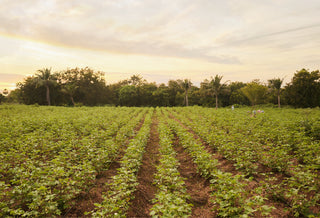
Eswari cooking over the fire outside her house. She often adds local herbs to her soups and curries.
Over the past year or so, the Christy Dawn community has explored the healing qualities of plants native to Southern California. It was incredible to see Eswari light up when we asked about nourishing herbs on the farm. Eswari has been living and working with the land for over forty years. She considers the flora surrounding the farm her hospital and has a deep understanding of its medicinal properties.
One afternoon Eswari brought us around the farm, explaining what ailment each plant heals. She introduced us to over 20 plants and said that it was just the start.
“With the right herbs,
people can heal so much faster.”-Eswari
Eswari’s specific knowledge of each herb was impressive. For some, she explained in-depth recipes required to harness the plant’s healing potential. For others, she simply said, “Eat two.” Below is a sampling of the herbs she showed us and some details about how to prepare them.

Mudakathan Leaf
UseThe leaf is an anti-inflammatory that Eswari fries and eats to treat backaches
Keelandli Leaf
UseThis leaf treats jaundice
Paalpoodu Leaf
UseEswari cooks the leaf with coconut oil and onion to cure stomach issues
Erukalan Leaf
UseEswari boils it in coconut oil and uses the solution to treat ear infections
Tulsi
UseEswari soaks it in boiling water and lets it sit in the sun to help cure flu symptoms
Kuppamani Leaf
UseThe root acts as an expectorant to treat asthma and pneumonia
Thuthipoo Leaf
UseEswari uses it to cure fevers. She adds it to a soup and serves it hot
Maringa Leaf
UseThe leaf treats some symptoms of diabetes
Aloe
UseThe milk from the plant is used to cool down the body
Sirukeerai leaf
UseIt has high nutritional value and keeps blood sugar levels down
Like the regenerative, traditional farming methods used historically in India, knowledge of herbal medicine is decreasing. A majority of the knowledge about these traditional practices is held by the older generations. In the case of nourishing herbs, Eswari has noticed that the remedies that worked for her and her children have been largely forgotten by the younger generation who have moved away from rural communities in favor of big cities. She has high hopes that regenerative farming practices can help keep families and communities intact, thereby allowing for the wisdom of the healing properties of common plants to be passed down to the next generation. She believes strongly that local herbs can heal her community and ecosystem faster and more effectively than chemical alternatives.

Eswari on the edge of the farm where she forages for nourishing herbs.
Her knowledge of the local ecosystem goes beyond nourishing herself and her family: she is constantly contributing her traditional knowledge to healing the soil. Much of the plants that nourish our bodies have the same effect on the Earth. Whenever the cotton plants look weak or sick, Eswari is the first person we turn to for advice on which herbs to infuse into a natural fertilizer or pesticide. Although the farm is just a small plot of land, with Eswari’s knowledge it is a self-sustaining ecosystem that supports both the Earth and the people who care for it.






